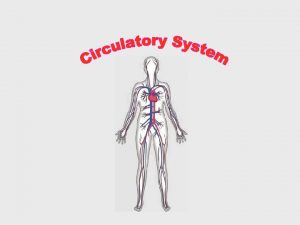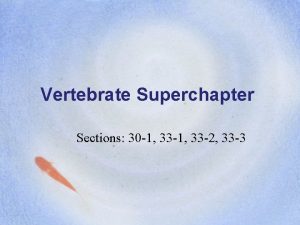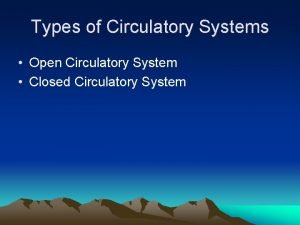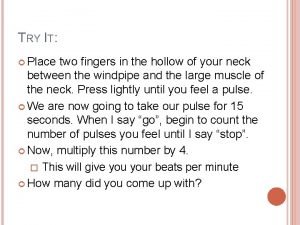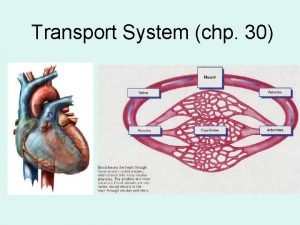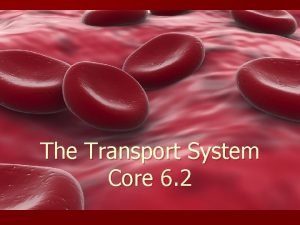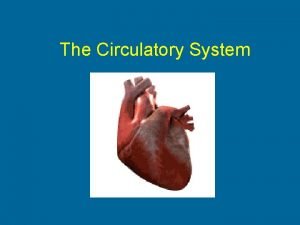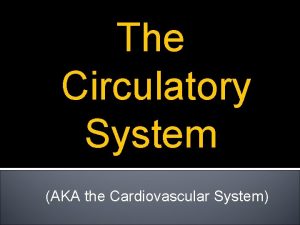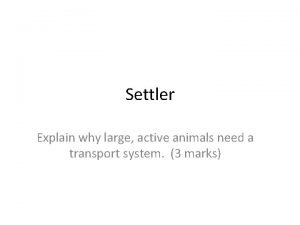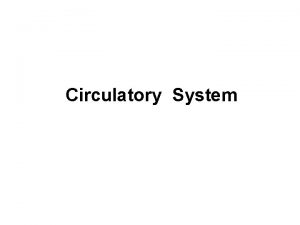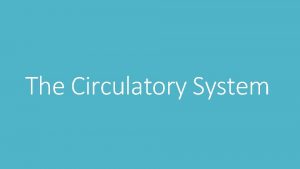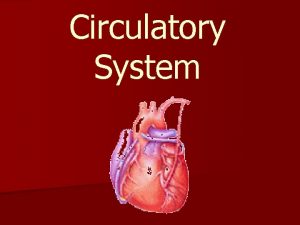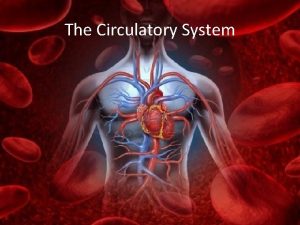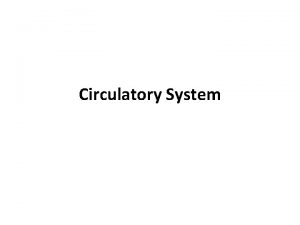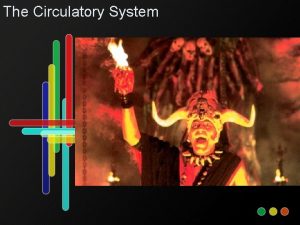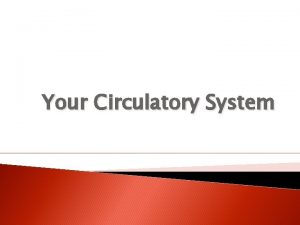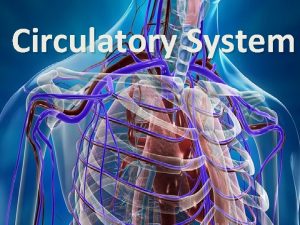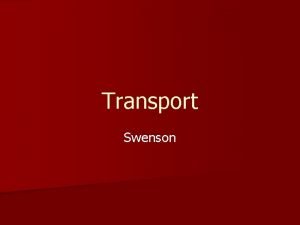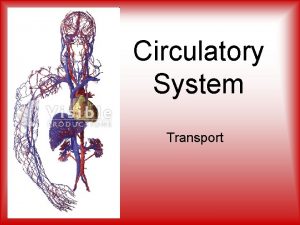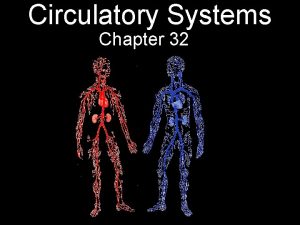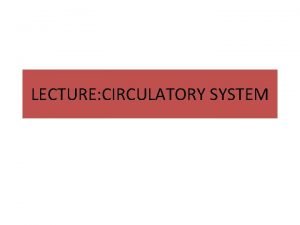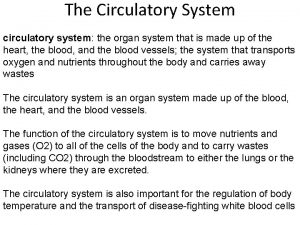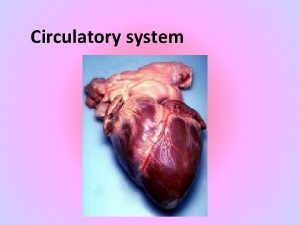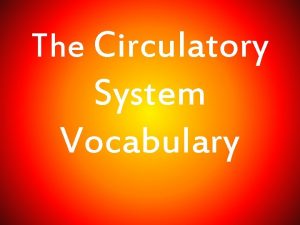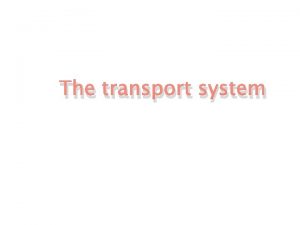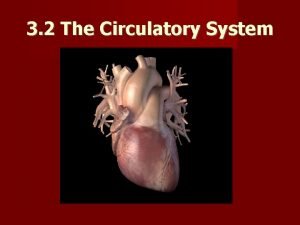The Circulatory System Circulatory system the transport system





















- Slides: 21

The Circulatory System

Circulatory system – the transport system of the body It has 4 main functions: • Transportation of O 2 and CO 2 • Distribution of nutrients and transport of wastes • Maintenance of body temperature • Circulation of hormones


It consists of 3 general components: • A fluid in which materials are transported, such as blood • A system of blood vessels or spaces throughout the body in which the fluid moves • A pump, such as the heart, that pushes the fluid through the blood vessels or spaces Cardiovascular system – part of the circulatory system comprising the heart and blood vessels

Heart Structure The mammalian heart consists of a double pump separated by a wall of muscle called the septum – separates the right heart pump from the left heart pump Each pump consists of: • A thin-walled atrium – receives blood from veins • A thick-walled ventricle – delivers blood to arteries


Blood Vessels Arteries carry blood away from the heart • They have thick, muscular walls • Most arteries carry oxygenated blood away from the heart to other parts of the body – Exception: pulmonary artery carries deoxygenated blood from the heart to the lungs • Aorta – largest artery in the body leading directly from the heart and carrying oxygenated blood to the tissues of the body – Blood goes from the aorta, to major arteries, to smaller arterioles, into capillaries


Veins – carry blood back to the heart Have thinner walls, not very elastic • Since veins cannot help with the pumping of blood due to their thin walls, veins have valves that only allow blood flow in one direction. • Also, the contraction of skeletal muscle helps pump blood back to the heart • Most veins carry deoxygenated blood back to the heart – Exception: pulmonary vein that carries oxygenated blood from the lungs to the heart • Vena cava – largest vein in the body that connects directly to the heart – Blood goes from the capillaries, to the venuoles, to the veins, and then to the vena cava




Flow of Blood Through the Heart Deoxygenated blood enters the heart through the superior vena cava or the inferior vena cava and goes into the right atrium The tricuspid atrioventricular (AV) valve opens and the deoxygenated blood enters the right ventricle The pulmonary semilunar valve opens and the blood enters the pulmonary artery which brings the deoxygenated blood to the lungs In the lungs, the blood cells drop off CO 2 and pick up O 2

The oxygenated blood returns to the heart through the pulmonary vein and enters the left atrium The bicuspid atrioventricular (AV) valve opens and the blood enters the left ventricle The aortic semilunar valve opens and the blood enters the aorta where it is pumped to the rest of the body


Heart Rhythms, Sounds, and Pressure Sinoatrial (SA) node – a small mass of tissue in the right atrium that originates the impulses stimulating the heartbeat; acts as a pacemaker Atrioventricular (AV) node – a small mass of tissue through which impulses from the SA node are passed to the ventricles, causing them to contract in unison

Conducting Systems • http: //highered. mcgrawhill. com/sites/0072495855/student_view 0/ch apter 22/animation__conducting_system_of_t he_heart. html

The “lubb-dubb” sound is caused by the closing of the heart valves • Diastole – relaxation of the heart, during which the cavities of the heart fill with blood • Systole – contraction of the ventricles, during which blood is pushed out of the heart – The increase in pressure during systole forces the AV valves shut, causing the “lubb” sound – As the ventricles relax, the pressure inside them decreases and blood flows into them. – This decrease in pressure causes the semilunar valves to close, preventing blood from flowing backwards into the ventricles, causing the “dubb” sound

Heart Sounds • http: //highered. mcgrawhill. com/sites/0072495855/student_view 0/ch apter 22/animation__the_cardiac_cycle__quiz _1_. html

Pulse – change in the diameter of the arteries that can be felt on the body’s surface following heart contractions Blood pressure – the pressure exerted on the walls of the arteries when the ventricles of the heart contract • Normal = 120/80 (systolic/diastolic) • Low blood pressure – reduces the body’s capacity to transport blood • High blood pressure – can weaken an artery, resulting in its rupture

Blood Composition Blood is made of 55% plasma, 45% red blood cells, and less than 1% white blood cells
 Digestive system circulatory system and respiratory system
Digestive system circulatory system and respiratory system Antiporter
Antiporter Active transport
Active transport Now answer the following questions
Now answer the following questions Active transport vs passive transport venn diagram
Active transport vs passive transport venn diagram Endocytosis vs exocytosis
Endocytosis vs exocytosis Primary active transport vs secondary active transport
Primary active transport vs secondary active transport Bioflix activity membrane transport active transport
Bioflix activity membrane transport active transport Active transport image
Active transport image Isotonic in biology
Isotonic in biology How respiratory system work with circulatory system
How respiratory system work with circulatory system Circulatory system and respiratory system work together
Circulatory system and respiratory system work together Circulatory system steps in order
Circulatory system steps in order Single loop circulatory system
Single loop circulatory system Lungfish circulatory system
Lungfish circulatory system Do clams have an open or closed circulatory system
Do clams have an open or closed circulatory system Circulatory system of a cow
Circulatory system of a cow Carbon dioxide levels in the blood
Carbon dioxide levels in the blood Closed circulatory system
Closed circulatory system Main parts of circulatory system
Main parts of circulatory system Smallest blood vessel
Smallest blood vessel Double circulatory system
Double circulatory system












